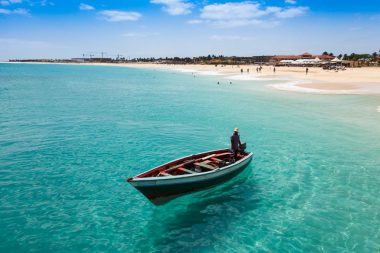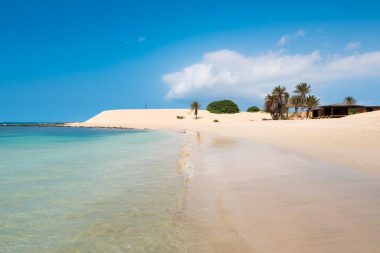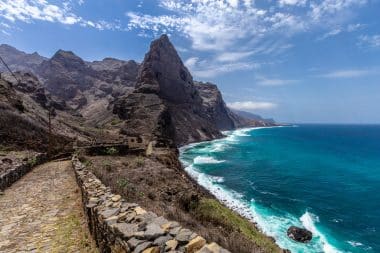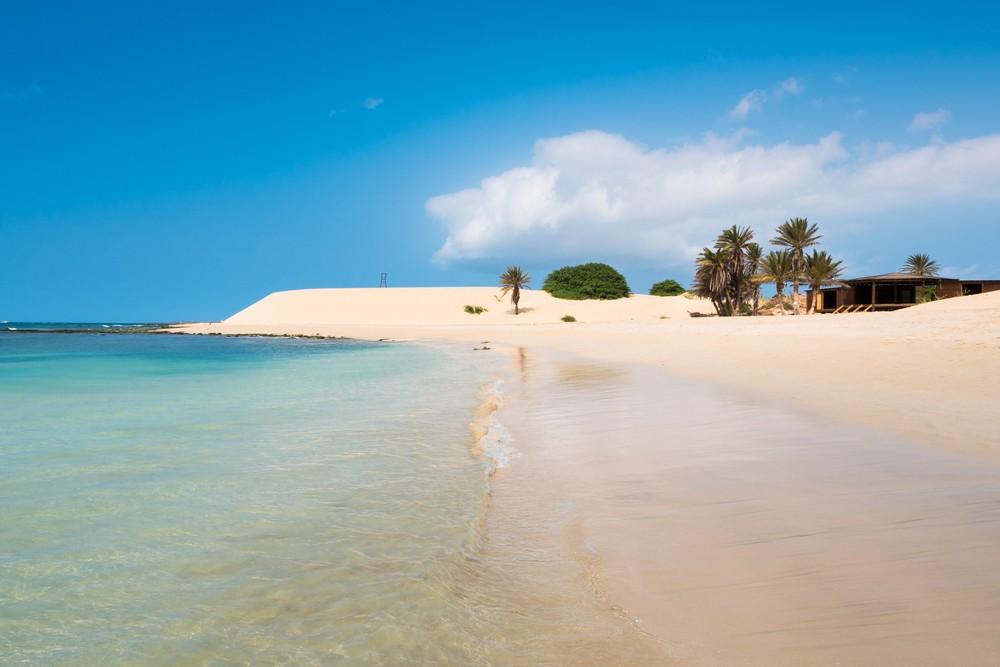The Cape Verde Islands are mountainous. Some holidaymakers have long since discovered them as hiking destinations or have even made them a classic of their outdoor activities. They protrude from the Atlantic Ocean like green-gray dabs and owe their existence to volcanism. Even in ancient times, they were never part of the neighboring African continent. If you go on a trekking holiday to Cape Verde, you will walk on your paths through countless valleys shaped by the maritime climate and, above all, on the paths that date back to the colonial era. However, the Cape Verde Islands are ideal for “hopping”, because ferries also run to those shores that do not have an airport.
If you want to see something different, far off the beaten tourist track, then the islands of Cape Verde are the right place for you. As an exotic destination with its own beauty, the Cape Verde archipelago is an insider tip for travellers to Africa or holidaymakers who want to stay exclusively on them.
Cape Verde is an African country in the Atlantic Ocean. It is an archipelago off the coast of Senegal. The official language is Portuguese, as the islands were uninhabited until they were discovered by the Portuguese in the 15th century. There’s too much to see in Cape Verde, from beaches and colonial towns to active volcanoes and more. Originally, these islands were covered by dense vegetation that contrasted with the black volcanic rocks and the blue sea. The archipelago is part of the Macaronesia region. It consists of ten large and five smaller islands. Sal Island is home to the large Amilcar Cabral International Airport. On the island of Santiago is Praia, the largest city and capital of Cape Verde.
This unique archipelago is always good for a surprise, as its islands are of volcanic origin. Most of the islands are made up of mountains covered in volcanic ash, so there is hardly any vegetation. Getting to the islands is very easy. Cape Verde has four international airports, which is amazing in itself. As far as culture is concerned, you will be surprised by the strong European and African influence. It’s a very special mix. You will find that the music is very diverse and includes French, Portuguese and African rhythms.

Several regions of the Cape Verde Islands enjoy a magnificent backdrop with deserted wide beaches such as Praia da Ribeira Seca, where the waves kiss the steeply sloping mountains of Santo Antao. The villages cling to the slopes like swallows’ nests. Fontainhas is one of those picturesque places in a unique setting, where the farmers work hard to cultivate their fields on vertiginous terraces.
The islands of Cape Verde
For less than half a million people, the nine inhabited islands of Cape Verde became home. One of them is Fogo, which rises almost like a circle from the Atlantic Ocean and where the three thousand meter high volcano Pico de Fogo is the main attraction. Fogo is borrowed from the Portuguese language and can be translated as “fire”. The giant among the mountain giants of the archipelago has not slept since 1995 and regularly spits its lava masses over the crater rim. But the people at its feet keep returning here, growing apples or quinces and producing their heavy and red wine.

The people of Cape Verde leave no doubt that they are proud to be able to live on “islands of bliss”. And none of these islands are like any other. Sometimes the landscape resembles a barren desert, then it enchants more with picturesque beaches. Equally rich in facets is the flora with banana, mango and citrus trees as well as mighty palm trees. Green oases and the traces of volcanic activity alternate on the island of Sal. It owes its name to the numerous salt pans where the sun robs the sea of salt.
Surfers from all over the world are attracted to the long sandy beaches of the Cape Verde Islands between November and July. Hoping to catch the famous “super wave”, they populate the region around Santa Maria. In the numerous restaurants of the village with its pastel-colored houses, the culinary delights of the sea end up on the table. And if you want to learn a little more about salt production, you should go to the historic weighing house on the harbour quay. As a paradise for divers, the reefs and caves near Palmeiras are recommended on Sal .
Santiago is the largest of the Cape Verde Islands and offers almost everything that water rats and sun worshippers dream of on their holiday: sand, beach and many a place that is suitable for relaxing for a few days. The capital Praia is anything but hectic and rather blessed with a cozy flair. Traces of colonial history can be found in the old town with the church of Nossa Senhora da Graca and the fortress of Beteira. Bars and restaurants can be found in the Achada de Santo Antonio district.
Holidaymakers who have made their way to Santo Antao should definitely make a detour to the Val de Paul. The valley with its numerous almond trees and flowering hibiscus can be hiked through with pleasure. And there you will also encounter the sugar cane plantations, from which the national drink grogue is conjured up in the distilleries. And Boa Vista is also becoming increasingly popular as a travel destination.
1. Sal

As the name suggests, the main industry on Sal has always been salt production. The name translates as “salt”. In the past, the mined salt was shipped to Brazil , but today you can buy it on the island. Sal is now a popular tourist destination and has the main international airport in Cape Verde. It is mainly a flat, sandy island that is a mecca for surfers in winter due to the trade winds.
2. Santiago
The island of Santiago is the largest island in Cape Verde and is home to half of the country’s population. The first of the islands to be settled is home to the country’s capital, Praia. The island is a good place to see some endangered animal and plant species, including 38 plants and several rare birds. At the Sucupira Market in Praia, you will find many local products from artists and you will have the opportunity to taste traditional food.
3. Boa Vista

The combination of mountains, desert, and beaches makes Boa Vista a great destination. Boa Vista is the third largest island in the archipelago. Since the opening of an international airport in 2007, more and more tourists have been discovering the island closest to Africa. Be sure to visit the beautiful colonial-style church near the square in Sal Rei, the island’s capital. The salt produced here was considered “genuine” because of its high quality.
4. Sao Nicolau
The island impresses with its varied landscape and is very popular with hikers and mountain bikers alike due to its valleys and mountains. However, access to the island’s beach is not suitable for everyone, which is why Sao Nicolau is less suitable for beach vacationers. But the colorful houses of the island still make a visit highly recommended. The capital Ribeira Brava is worth visiting during a market day in the morning to capture the atmosphere.
5. Maio
Maio is particularly characterized by its many picturesque beaches. Although there are few plants on Maio, Maio still has the largest forest in Cape Verde. Maio is also ideal for observing ospreys, terns and larks. The picturesque Morro has a large swimming beach that you will share with the turtles in the summer.
6. Brava
Brava has some advantages. At about 11 km, it is the smallest inhabited island in Cape Verde. You probably won’t meet many people on Brava, because there is simply not enough space for large crowds on the tiny island. It is also the greenest of the Cape Verde islands, which makes it very scenic. Most of the inhabitants, descended from former whalers, are engaged in fishing and agriculture, growing sweet potato, coffee and bananas. Vila Nova Sintra has the reputation of being the most beautiful town in the entire archipelago.
7. Santo Antao

Santo Antao, the second largest island in Cape Verde, is famous for its mountains. Although the island appears desolate in places, it has lush subtropical vegetation with spruce, pine, date palm and coconut palms. Ribeira Grande, the capital and largest city of the island, is a lively place. Be sure to visit the food and clothing market, and enjoy a sense of tranquility at the Church of Nossa Senhora do Rosario. In the port city of Porto Novo, you can buy locally made goat cheese.
8. Fogo
The island of Fogo is the highest island in the Cape Verde chain. The reason for this is Fogo Peak, which is 2,829 meters high. The volcano has erupted regularly since 1680, most recently in 2014. The rich volcanic soil makes the coffee on Fogo very good, so you should have a cup during a break. The island is also known for its good wines. A popular activity on the island is climbing Pico, a hike that takes about six hours from the village of Cha das Calderas.
9. Sao Vicente
Sao Vicente is a dry island characterized by low mountains. Most of the island’s 80,000 inhabitants live in Mindelo, which is considered the cultural center of Cape Verde. This is where the different musical styles of Cape Verde have their origins. In Mindelo, be sure to visit the fish market and the copy of Lisbon’s famous Belém Tower. The city has an African flair, which is due to trade with this continent.
10. Santa Luzia
The smallest island in Cape Verde is basically uninhabited, but it attracts sailors like honey attracts flies. The island is low, which means plenty of sun, and the north-easterly trade winds make it a popular but secluded anchorage for yachts. It may look desolate, but a rugged coastline with rocks eroded by the wind gives it a picturesque character.
Cape Verde is undoubtedly an archipelago that is gradually becoming a competitor to the Canary Islands and is an Eldorado for adventurous holidaymakers.
Travel information Cape Verde
| Capital | Praia |
|---|---|
| Form of government | Parliamentary Republic Parliamentary democracy |
| Currency | Cape Verde Escudo (CVE) |
| Area | approx. 4,033 km² |
| Population | approx. 546,400 (2017) |
| Languages | Portuguese |
| Electricity grid | 220 volts, 50 Hz |
| Area code | +238 |
| Time zone | UTC-1 |


